
Museum Guide
Gallery Guide
Curator's introduction
Mesolithic Thanet
Revolution or evolution?
List of Displays
Scales in centimetre divisions
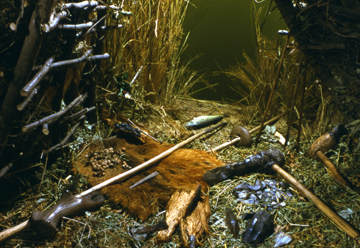
Copyright Museum of London
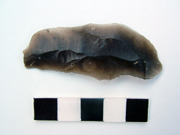
A flint blade from Thanet Reach
The
Early Mesolithic period saw the continued re-population of Britain
The distinction of the Mesolithic from
the preceding period is founded on
changes to the flint-working technology, rather than any
significant change in the hunter-gatherer way of life.
During the Earlier Mesolithic the
climate was warming and the landscape
was changing from frozen tundra to open forests of birch and pine and
ultimately to a dense mixed deciduous woodland of oak, alder and lime.
Rising temperatures and rising sea
levels eventually resulted in the
isolation of Britain Europe , as low lying areas that were once dry
land were inundated by melting glaciers. This process also led to the
forming
of the Wantsum Channel and the creation of
the Isle of Thanet .
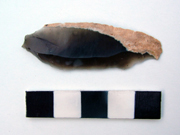
A flint blade from Thanet Reach
The isolation of Britain
The increasingly
wooded environment also
had an effect, prompting
changes in lifestyle and flint-working which were responses to the
development of new hunting and survival strategies.
As with the Upper Palaeolithic , Mesolithic flint-working technology is
characterised by the production of
blades. This represents the most economical way to extract tools from
the raw flint core, creating a minimum of waste.
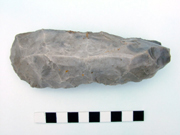
A non-local tranchet adze
This economy was important to a highly
mobile hunter-gatherer society
who did not dig or mine for flint and might only occasionally encounter
surface exposures of suitable raw material.
Mesolithic tools could be small and light, often manufactured on blade-flakes knapped from good quality flint (where available). However heavy duty artefacts such as adzes, axes and picks were also created and employed.
Mesolithic tools could be small and light, often manufactured on blade-flakes knapped from good quality flint (where available). However heavy duty artefacts such as adzes, axes and picks were also created and employed.
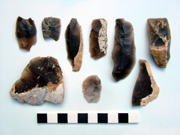
Flints from Thanet Reach
Groups of flints that probably represent
debris from temporary camps
have been recovered from Quex Park Stone Bay Thanet Reach Business Park and possibly Chilton QEQM Hospital
An archaeological evaluation at Thanet
Reach Business Park produced stake holes and a pit probably dating to
the Mesolithic.
This dating is likely but not certain, although the features
should be no later than the Early Neolithic period, a time when our
first farming ancestors were beginning to establish themselves.
The period around 4000 BC saw the
transition between the Late
Mesolithic and the Neolithic and people who were living both
‘Mesolithic’ and ‘Neolithic’ lifestyles co-existed in the landscape for
a time.
Revolution
or evolution?
It should not be imagined that our Mesolithic hunter-gatherer ancestors were physically replaced by a wave of incoming ‘Neolithic’ people, as probably happened in theUpper Palaeolithic when the Neanderthals were out-competed
by our direct ancestors, the Modern Human Homo Sapiens Sapiens.
It should not be imagined that our Mesolithic hunter-gatherer ancestors were physically replaced by a wave of incoming ‘Neolithic’ people, as probably happened in the
It is more likely that many Mesolithic
hunter-gatherers just began to
adopt a new way of living that settlers were
bringing across the Channel.
There is evidence from elsewhere in Britain
Display 1: Gazetteer of Mesolithic sites on Thanet
Including both identified and potential Mesolithic sites.
Display 2: Thanet Reach Business Park
A review of the only Thanet site known to have produced features which likely date to the Mesolithic.
Display 3: Mesolithic flint axes from Thanet
Version 1 - Posted
Version 2 - Posted 12.04.06
Version 3 - Posted 21.10.06
All
content © Trust for Thanet Archaeology